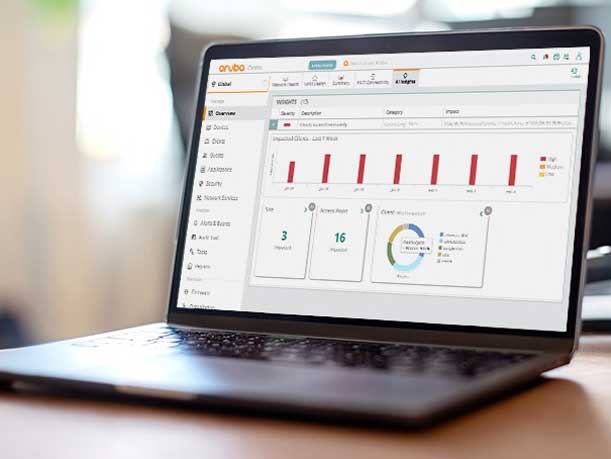Partners: Latest Aruba Central Network Management Platform ‘Paints A Picture Worth A Thousand Words’
‘This is an evolution, not a new product. The new generation of Aruba Central really speaks to the idea that the networking team needs to be as efficient as possible as the network grows more complex, more distributed and operates on the edge to the cloud,’ Larry Lunetta, vice president of WLAN and security solutions marketing, tells CRN ahead of Aruba Atmosphere 2023.

Aruba, a Hewlett Packard Enterprise company, wants to help channel partners and enterprises get the most out of their networks, according to the wireless specialist at Aruba Atmosphere 2023.
The company took to the event to reveal the next generation of its popular network management platform, HPE Aruba Networking Central.
“This is an evolution, not a new product. The new generation of Aruba Central really speaks to the idea that the networking team needs to be as efficient as possible as the network grows more complex, more distributed and operates on the edge to the cloud. That clearly means more analytics and artificial intelligence,” said Larry Lunetta, Aruba’s vice president of WLAN and security solutions marketing.
The mission of the network is to capture, secure, transport and deliver data to users, devices and applications wherever they live, Lunetta said. “You can see why the business owners are now asking more of the network and asking how the network can support their objectives,” he added.
“From a sales standpoint, a picture paints a thousand words so as a partner trying to sell Aruba solutions, when you can demonstrate an interface like this that’s intuitive, saves time and it makes it easier to do your job, those are all things that resonate with customers and users,” said Joel Grace, senior vice president of IT infrastructure and cloud practice for Sayers, a Vernon Hills, Ill.-based solution provider.
And for partners, the Aruba Central platform makes demonstrations and IT management much easier, Grace said. “Helping customers with services in their environment and troubleshooting faster and easier is always a win for both parties,” he said.
The updated interface is less about dashboards and more geared toward the end-user perspective that fits well into “the day in the life of a network administrator,” Grace said.
“[Network administrators] don’t spend a lot of time in the console unless something goes wrong,” he said. Using the latest version of Aruba Central, these professionals can “pop in, see a red light and drill into this site, this device, this access point,” he said.
The first version of Aruba Central, which focused on Wi-Fi management, was introduced in 2014 as customers were moving workloads to the cloud. In 2020, the Santa Clara, Calif.-based company launched the Aruba Edge Services Platform (ESP) to unify management across different IT silos and added AI, which now runs natively on HPE GreenLake.
The latest edition of HPE Aruba Networking Central includes an operator-centric design with a simplified user experience for more people across all skill levels, a “time-travel” feature, which Aruba is calling the first in the industry that gives contextually correlated “point-in-time” views of the network for recovery in minutes to a specific point, and multilayer physical and logical “sunburst” topology views for the viewing of large, complex networks. It also includes intelligent assurance indicators for device health and customer experience, AI-powered full-stack insight for enhanced root cause analysis, impact assessment, and precise recommendations and device-agnostic day zero and day one workflows with API support to automate network configurations at scale, according to the company.
Seamless network management has become even more important as organizations adopt a hybrid strategy, Aruba’s Lunetta said. “We think about the network as the central nervous system of a hybrid cloud environment,” he added.
For PIER Group, a Jasper, Ind.-based solution provider and Aruba partner, because the previous version of Aruba Central was geared toward enterprises that had more IT expertise and dedicated engineers, the updated platform gives its main customer base—large university campuses—a true cloud experience, said Jason Coclanes, named account manager of networking for PIER Group, which stands for Partners In Education and Research.
“Past interfaces [of Aruba Central] were designed by engineers and had that look and feel, whereas today’s generation of graphical interface is more interactive and is built for things like, ‘What else can I get out of the data that my environment can offer and not just be reactive in management?’ Coclanes said.
The updated platform can also help customers do more with less, especially when it comes to combating the IT skills gap, Coclanes added.
Enterprises must manage data coming at them from all parts of the network, including at times fragmented silos of management from a wired, wireless and security perspective, Aruba’s Lunetta said. “The idea of the next generation of Central is to build on basically 10 years of experience now to allow us to introduce this new set of capabilities,” he said.
The next generation of Aruba Central takes advantage of the AI and the data lake that supports the AI that comes from Aruba customers to help enterprises better automate their workflows, view relevant data and manage the network. Aruba believes it has the most relevant, integrated data lakes for networks in the industry.
“You can say, ‘What about Cisco?’ Cisco’s got two major management platforms and they spread their data out. This is all in one place. It’s all consolidated [and] curated, so it’s available to train AI models on an ongoing basis to continue to improve their results. And we get telemetry from across the network. It’s not just volumes of data, it’s the right data,” Lunetta said.
Aruba is also updating the architecture of ESP, which previously had three layers, unified infrastructure, security and AI-based automation. The company is adding Network as a Service as a fourth integrated layer within ESP. “[That’s] because it really leverages the other layers to actually deliver the solution,” Lunetta said.